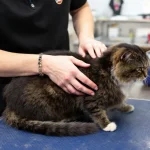When a cat bites, it communicates various messages depending on the context and the cat’s individual personality. Here are several potential reasons why your cat might bite you and what each one might signify:
- Playful behavior: Cats often engage in playful biting, especially when they’re young. This behavior is typically gentle and may involve batting or nibbling without causing harm. It’s a natural part of feline play and socialization.
- Overstimulation: Cats have a threshold for how much petting and handling they can tolerate before becoming overstimulated. If you’re petting your cat and they suddenly bite, it could be a sign that they’ve had enough and need a break.
- Attention-seeking: Some cats bite to get your attention or to initiate interaction. They may learn that biting results in a response from you, even if it’s not the one they want.
- Fear or anxiety: Cats may bite when they feel threatened, scared, or anxious. This could happen if they’re startled or if they’re in an unfamiliar or stressful environment. Biting serves as a defensive mechanism in such situations.
- Pain or discomfort: Cats may bite as a response to pain or discomfort, particularly if you touch a sensitive area on their body. It’s essential to be mindful of any signs of pain or illness in your cat and to avoid touching areas that may be causing them discomfort.
- Miscommunication: Sometimes, cats may misinterpret our actions or signals, leading to a biting response. For example, they may interpret rough petting as aggressive behavior and react defensively.
- Redirected aggression: Cats may redirect their aggression towards you if they’re unable to direct it towards the actual source of their frustration, such as another cat or an outside stimulus.
Understanding the underlying cause of your cat’s biting behavior is crucial for addressing it effectively. In most cases, providing appropriate outlets for play, setting boundaries, and respecting your cat’s signals can help reduce biting incidents. If the behavior persists or is accompanied by other concerning symptoms, it’s advisable to consult with a veterinarian or a certified animal behaviorist for further evaluation and guidance. They can help identify any underlying issues and develop a behavior modification plan tailored to your cat’s needs.






